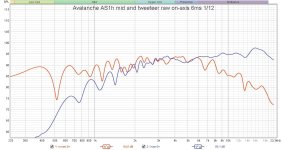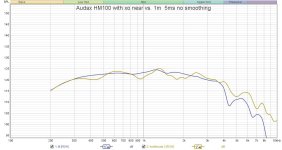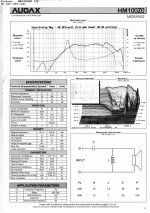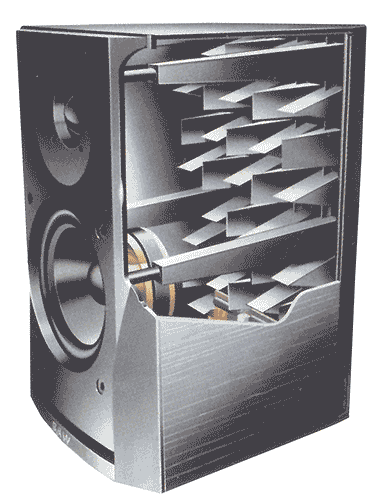More Weird ideas!
Trying to combat the evil of rear cabinet reflection without the obvious solution-fiberglass or sheep wool.
Will it work? what do you think will happend?

Trying to combat the evil of rear cabinet reflection without the obvious solution-fiberglass or sheep wool.
Will it work? what do you think will happend?
I'd make all the cones different heights, and fill their insides with something absorbent.
Yes, I thought about puting some insallation inside, will be simillar to the the tapered tubes of Laurence Dickie Nautilus designer, on revers.
Hi,
Physical object features have strong effect on sound whose wavelength is similar in size, and effect reduces the longer the wavelength compared to size o the feature. Most problematic mode inside box is the first one, which is half wavelength, so basically it is not possible to fit anything "diffusing" inside the box, that would be maximally effective as it would not fit inside the box. Any physical features that fit inside are effective to the higher modes, with shorter wavelength. This is also where the wool is most effective on. Thus the first modes always remain the most problematic if any, and you could mitigate in other ways, by reducing dimensions inside and location of the transducer(s), or perhaps try some resonator.
Perhaps there is some effective enough solution that has some effect, like some features with absorption. See KEF metamaterial tweeter, and Yamaha NS-5000 paper, for some recent examples. Quarter wavelength resonance / absorption stuff could fit to mitigate half wavelength stuff.
Physical object features have strong effect on sound whose wavelength is similar in size, and effect reduces the longer the wavelength compared to size o the feature. Most problematic mode inside box is the first one, which is half wavelength, so basically it is not possible to fit anything "diffusing" inside the box, that would be maximally effective as it would not fit inside the box. Any physical features that fit inside are effective to the higher modes, with shorter wavelength. This is also where the wool is most effective on. Thus the first modes always remain the most problematic if any, and you could mitigate in other ways, by reducing dimensions inside and location of the transducer(s), or perhaps try some resonator.
Perhaps there is some effective enough solution that has some effect, like some features with absorption. See KEF metamaterial tweeter, and Yamaha NS-5000 paper, for some recent examples. Quarter wavelength resonance / absorption stuff could fit to mitigate half wavelength stuff.
Last edited:
Hmm, revisiting diffusers, they also work with quearter wavelength, so perhaps there is possibility to diffuse as well, but where would it diffuse? Perhaps it's most effective to use absorption or resonance, somehow lose the energy than divert it as there is nowhere to go inside a box.
Here is paper that shows something about the KEF meta tweeter stuff, also about modes inside a box: https://assets.kef.com/product-support/r-series-meta/KEF_R_Series_with_MAT_WhitePaper_v2.pdf I think there was more elaborate one somewhere few years back but couldn't find it in a hurry.
They have ~about ten filters per octave, so on a midrange driver perhaps 3 octaves wide pass band there would be thirty. Perhaps too tedious, and if space is not a problem it would be simpler to use absorption and perhaps one or two resonators to knockdown the remainder low modes. This could be what Yamaha NS5000 does with their woofer. Not sure how the tweet and mid "boxes" work, some impedance equalization or something.
It looks like KEF has input on the center (of back panel)? or if it's full coax size meta stuff the entry could be size of the tweeter so inputs just somewhere on the backpanel. Perhaps put two 1/4wave pipes, one length that is roughly half of depth of your box, and another pipe half of that to target the second mode. I have no idea what the input area needs to be, and whether absorption in the channels help or not, and whether the pipes need to be outside of the box in order not to change the internal depth that makes the resonance. Hole back of the box would at least allow easy prototyping of the resonator tubing.
Here is paper that shows something about the KEF meta tweeter stuff, also about modes inside a box: https://assets.kef.com/product-support/r-series-meta/KEF_R_Series_with_MAT_WhitePaper_v2.pdf I think there was more elaborate one somewhere few years back but couldn't find it in a hurry.
They have ~about ten filters per octave, so on a midrange driver perhaps 3 octaves wide pass band there would be thirty. Perhaps too tedious, and if space is not a problem it would be simpler to use absorption and perhaps one or two resonators to knockdown the remainder low modes. This could be what Yamaha NS5000 does with their woofer. Not sure how the tweet and mid "boxes" work, some impedance equalization or something.
It looks like KEF has input on the center (of back panel)? or if it's full coax size meta stuff the entry could be size of the tweeter so inputs just somewhere on the backpanel. Perhaps put two 1/4wave pipes, one length that is roughly half of depth of your box, and another pipe half of that to target the second mode. I have no idea what the input area needs to be, and whether absorption in the channels help or not, and whether the pipes need to be outside of the box in order not to change the internal depth that makes the resonance. Hole back of the box would at least allow easy prototyping of the resonator tubing.
Last edited:
Yes, I thought about hanging panels sheets of vinyl floor leftovers and see (hear) what happens, one can stack several of them one after the other, would be very intresting to hear if there's any difference at all.Hmm, revisiting diffusers, they also work with quearter wavelength, so perhaps there is possibility to diffuse as well, but where would it diffuse? Perhaps it's most effective to use absorption or resonance, somehow lose the energy than divert it as there is nowhere to go inside a box.
Here is Laurence Dickie explains about Tapered tube, from ca. 2min on. Fascinating guy, fascinating subject!
This is going to be a CNO25 (Troels Gravesen) 2 midrange, just didn't made effort to copy paste more tubesIs this a three way with a mid chamber?….or a tower 2 way?
Mk1 details are hidden.. Actually MkII xo is 2.0 type!
Is the box similar? It's almost 1000mm high - very low first mode! Troels uses lots of stuffing and covers walls with bitumen and felt. Perhaps some diffusers right behind woofers might attenuate mainly reflections directly from back- and sidewalls, around 1-3kHz.
Take nearfield measurements of woofers with diffusers! And as-is measurement for reference of course!
Is the box similar? It's almost 1000mm high - very low first mode! Troels uses lots of stuffing and covers walls with bitumen and felt. Perhaps some diffusers right behind woofers might attenuate mainly reflections directly from back- and sidewalls, around 1-3kHz.
Take nearfield measurements of woofers with diffusers! And as-is measurement for reference of course!
A preliminary search did not return any useful result on this topic so...
Is there any argument to be made in favour of utilising a an internal soundwave diffuser within an enclosure to break up standing waves or to any other benefit? Just to be clear, a diffuser role is understood not to absorb soundwaves, but merely change or sufficiently randomize their angle of reflection to break-up standing waves and resonant frequencies. In a studio or theatre environment, the panels can be quite large and cover a significant area. Lower frequency waves are longer than the longest dimension of most...
Is there any argument to be made in favour of utilising a an internal soundwave diffuser within an enclosure to break up standing waves or to any other benefit? Just to be clear, a diffuser role is understood not to absorb soundwaves, but merely change or sufficiently randomize their angle of reflection to break-up standing waves and resonant frequencies. In a studio or theatre environment, the panels can be quite large and cover a significant area. Lower frequency waves are longer than the longest dimension of most...
- lucadelcarlo
- Replies: 32
- Forum: Multi-Way
Nearfield measurement of my 3-way towers twin 8" woofers. Xo around 350Hz LR2. Box is 1000mm high, 5 corners. no padding at all on walls, just dacron on top and bottom. 7-800Hz is vertical mode anf response difference comes from difference in driver height.

Yamaha NS-5000 uses stuffed tubes of different length and area inside woofer box https://fi.yamaha.com/fi/products/contents/audio_visual/ns-5000/technology.html
Yamaha NS-5000 uses stuffed tubes of different length and area inside woofer box https://fi.yamaha.com/fi/products/contents/audio_visual/ns-5000/technology.html
Last edited:
D
Deleted member 375592
If you don't add any energy-absorbent material, you'll have a different distribution of resonance modes but the energy decay slope will stay essentially the same. So much energy is still absorbed per each reflection ... you can increase the number of reflections but you can't improve it drastically. Adding 3 layers of acoustic foam with increasing density and tapering the end (with a sloped wall or traffic cones - your choice) may be your best bet, relatively.
CNO-25 is 2.5 arrangement, obviously coils have different value.
Regarding internal diffusors B&W above has them on the back wall. The box has three dimensions, height is longes and nowdays width smallest. woofers tend to have large magnets that block direct path to backwall.... Looks like that B&W bos has no braces, which would work as diffusers too. Troels's instruction has two vertical braces, plates with three holes.
The basic principle of KEF meta diffusors for motor vents have several pathways of different length https://assets.kef.com/product-support/r-series-meta/KEF_R_Series_with_MAT_WhitePaper_v2.pdf
Regarding internal diffusors B&W above has them on the back wall. The box has three dimensions, height is longes and nowdays width smallest. woofers tend to have large magnets that block direct path to backwall.... Looks like that B&W bos has no braces, which would work as diffusers too. Troels's instruction has two vertical braces, plates with three holes.
The basic principle of KEF meta diffusors for motor vents have several pathways of different length https://assets.kef.com/product-support/r-series-meta/KEF_R_Series_with_MAT_WhitePaper_v2.pdf
To be honest, you're starting of with a cube, which is not the best starting point; I'd go for a double V diffuser (drawing), going from one side to the other, much like the single V diffuser (picture).
I did use a cube enclosure many years ago, and found different types of foam, in different layers worked well; however some experimentation was needed to find the best combination/order of foam. If memory serves my right, the first layer was a course open cell foam, followed with a finer foam against the rear wall. I may have used cotton wool as well.
So here’s the thing…..you’re working against time…..and that time is the speed of sound over the distance from the rear of the cone to the enclosure walls……and back again.
Stuffing reduces modes……..it makes those rear reflections chaotic with an infinite number of path ways to and from the cone…..doesn’t eliminate the problem….only mitigates it by stirring things up
Sealed drivers like mid domes…….reflection is fast and furious……..the time smear is insignificant in our application as the distance is so short. How do we simulate that and not change the system Q?
You’d need to have a concave barrier inside the enclosure as close the back of the driver as possible about 80% of the enclosure size that’s vented all around. Line the driver facing side with wool or similar. The volume behind the barrier….the convex side………stuff that area as heavily as you can without changing the Q much. Now the highest energy from the rear of the driver has the shortest path way back through the cone without a pressure zone behind it………the remaining back wave and pressure is diffused and partially absorbed by the stuffing. It’s the best you can do IMO if the goal is to mitigate reflections that will smear the direct sound from the cone.
Stuffing reduces modes……..it makes those rear reflections chaotic with an infinite number of path ways to and from the cone…..doesn’t eliminate the problem….only mitigates it by stirring things up
Sealed drivers like mid domes…….reflection is fast and furious……..the time smear is insignificant in our application as the distance is so short. How do we simulate that and not change the system Q?
You’d need to have a concave barrier inside the enclosure as close the back of the driver as possible about 80% of the enclosure size that’s vented all around. Line the driver facing side with wool or similar. The volume behind the barrier….the convex side………stuff that area as heavily as you can without changing the Q much. Now the highest energy from the rear of the driver has the shortest path way back through the cone without a pressure zone behind it………the remaining back wave and pressure is diffused and partially absorbed by the stuffing. It’s the best you can do IMO if the goal is to mitigate reflections that will smear the direct sound from the cone.
cracked case, I wonder if the shapes on back panel are needed at all and the "cones" would suffice? Those are close to 1/4 resonators for lowest depth mode.
How did you measure and evaluate performance when you were testing type boxes and damping?
Anyone have an infinite baffle test setup to test speaker sound with and without box on the back, and whether any tricks put inside box made the sound closer to no box?🙂
How did you measure and evaluate performance when you were testing type boxes and damping?
Anyone have an infinite baffle test setup to test speaker sound with and without box on the back, and whether any tricks put inside box made the sound closer to no box?🙂
I searched my measurements of drivers as nude or open back vs. boxed, but there are too many insecure variables that I have nothing to show you. Mic placement in nearfield of a cone has some effect and my practices are not standard enough. I got some ideas to improve my Avalanche mid's performance above 4kHz, but now I don't have time for testing...






- Home
- Loudspeakers
- Multi-Way
- Loudspeaker Chaos theory- inside diffuser
